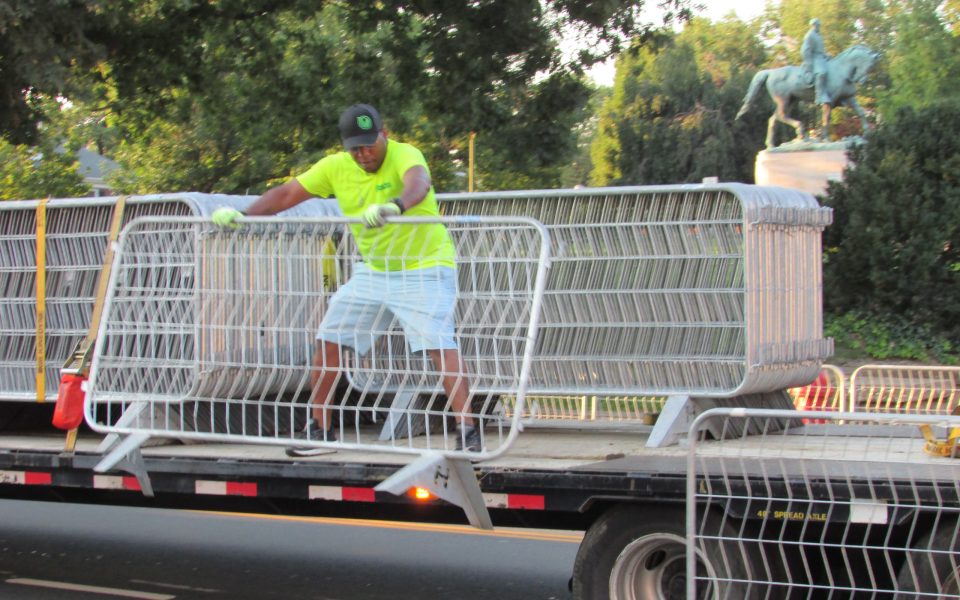After posting footage of a nonviolent antifascist column marching through the Downtown Mall in Charlottesville, Va. to pay respects to Heather Heyer on Aug. 11, I wrote this on my Facebook page:
“I appreciate all the comments expressing concern for my safety this weekend in Charlottesville and Washington, DC. So I don’t want to sound truculent in saying this. But please reserve your concerns for those who are in a far more precarious position than I. I am a white hetero male in a society that is structured for my comfort and safety. The police generally assume it is their duty to protect me instead of regarding me as a threat. Others are taking far taking far greater risks, and also I don’t have to deal with hostility and suspicion solely because of my skin color, gender and sexual orientation.”
I might have added that others take on far greater risks by willingly putting their bodies on the line to absorb white supremacist violence, whether nonviolently submitting to battering, fighting back or proactively using violence. They risk not only bodily injury, but the potential loss of livelihoods and reputations.
Let us remember that “antifa” is short for “antifascist.” Presumably, almost everyone who is not a fascist should be antifascist, including Dwight D. Eisenhower, the American soldiers who stormed the beaches of Normandy and everyone who supported the Allied war effort. “Antifa” is a shorthand that conflates the militant tactics of the black bloc with broad-based antifascism. Far-right activists like Jason Kessler and right-wing politicians alike use “antifa” as a slur to portray people of all walks of life, ages, abilities and tactical postures as mindless purveyors of violence and intolerance.
Although the expressions of concern towards journalists are appreciated, the risk of valorizing journalists in conflict zones is that the reporter perversely becomes the protagonist of the story, as if Ernest Hemingway was the hero of the Spanish Civil War. In Charlottesville, the protagonists are the people who live in that community. They are the radical clergy, the Black Lives Matter activists and residents of all races who bodily resisted the onslaught of white supremacist violence on Aug. 11-12, 2017 and still live with physical injuries, post-traumatic stress, anxiety attacks and depression. In Greensboro, the community I know the best, the protagonist in the struggle against fascism was the single mother on McConnell Road who frantically called for her children to come inside when Klansmen and neo-Nazis opened fire in the Morningside Homes public housing community in 1979.
A colleague with decades of experience teaching journalism gently chided me for saying that journalists on the whole are afforded more protection because of our professional status, noting the Committee to Project Journalists’ recent safety advisory for covering the Unite the Right rally and counter-protests in Washington, DC and Charlottesville.
The advisory pointedly notes, “These demonstrations are taking place against a backdrop of hostile rhetoric against large sections of the media. Journalists should keep in mind that if violence breaks out they could face arrest by police or be the target of physical or verbal assault by protesters.”
I observed some of that on Sunday as a black bloc materialized at the intersection of Pennsylvania Avenue and 17th Street after the police had safely whisked Kessler and his 19 supporters into Lafayette Park. I watched a member of the black bloc shove a photographer because he didn’t want his face to be photographed. A colleague was told ominously that their camera “might get messed up if anything happened.” During a lull in the action, two members of the black bloc heckled me, first suggesting that as a member of the media I was going to misrepresent them, then that I was an ambulance chaser seeking to exploit violent confrontations for media glory, and then absurdly asking whether I wanted “to allow Nazis to live in peace.” These things happened, but again, they’re not the story. If you want to know what I took away as the most important phenomena of two days in Charlottesville and Washington, DC in about 1,000 words, read my recent dispatch in the Progressive.
We live in an era when the president of the United States has repeatedly demonized the media, using terms like “enemy of the people.” People on all sides want to bait us into either condemning or endorsing the various players even as we’re gathering the news in fraught and confusing circumstances. It’s important for reporters to be present for far-right rallies and counter-protesters to memorialize an unfolding history, and also to chronicle events so that the conduct of neo-Nazis, the police, and yes, even antifascists, can be assessed in retrospect.
Journalists don’t need to be held up as heroes and showered with accolades. Collectively, we frequently make mistakes and fall short. We would all do well to review our work periodically and ask ourselves how we can do better. But I argue that now, more than ever, when we’re under attack, we need to fight to preserve our noncombatant status. Just give us a small measure of respect, and space to do our work.
Join the First Amendment Society, a membership that goes directly to funding TCB‘s newsroom.
We believe that reporting can save the world.
The TCB First Amendment Society recognizes the vital role of a free, unfettered press with a bundling of local experiences designed to build community, and unique engagements with our newsroom that will help you understand, and shape, local journalism’s critical role in uplifting the people in our cities.
All revenue goes directly into the newsroom as reporters’ salaries and freelance commissions.


Leave a Reply